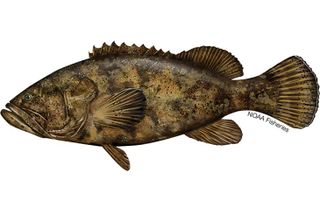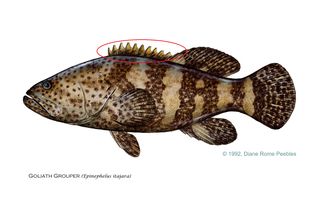Goliath grouper
The Atlantic goliath grouper or itajara (Epinephelus itajara), is a saltwater fish of the grouper family and one of the largest species of bony fish.[1] The species can be found in the west ranging from northeastern Florida, south throughout the Gulf of Mexico and the Caribbean Sea, and along South America to Brazil. In the east the species ranges West Africa from Senegal to Cabinda. The species has been observed at depths ranging from 1 to 100 meters (3.28 to 328 feet).
Description
The Atlantic goliath grouper can grow to lengths of 2.5 meters (8.2 feet) and weigh up to 363 kilograms (800 pounds). The species ranges in coloration from brownish yellow to grey to greenish and has small black dots on the head, body and fins. Individuals less than 1 meter (3.28 feet) in length have 3 to 4 faint vertical bars present on their sides. The species has an elongate body with a broad, flat head and small eyes. The lower jaw has 3 to 5 rows of teeth with no front canines. The scales are ctenoid. The dorsal fins are continuous with the rays of the soft dorsal fin being longer than the spines of the first dorsal fin. The pectoral fins are rounded and notably larger than the pelvic fins. The caudal fin is also rounded. The species typically preys on slow moving fish and crustaceans.
Habitat
Adult individuals are typically found in rocky reefs, wrecks, artificial reefs, and oil platforms. The species can also be found in coral reef habitats, but are much more abundant in rocky reef environments. Juveniles mainly inhabit mangrove environments, but can also be found in holes and under ledges of swift tidal creeks that drain mangroves. Mangroves serve as an essential nursery habitat for the Atlantic goliath grouper and necessitate specific suitable water conditions to nurture healthy, sustained goliath grouper populations. Juvenile goliath groupers may remain in mangrove nursery habitats for 5 to 6 years before leaving towards deeper offshore reef habitats at around 1 meter in length.
Reproduction
The Atlantic goliath grouper has a longevity of 37 years and reaches first maturity after 6 years, which leads to an estimated generation length of 21.5 years. The species has been hypothesized to be protogynous hermaphrodites, but this has yet to be confirmed. Males become sexually mature at around 115 centimeters (45 in) in length, and at ages 4–6. Females mature at around 125 centimeters (49 in), and at ages 6–8. The species has relatively small spawning aggregations of less than 150 individuals with no evidence of spawning outside of these aggregations.
Conservation
Atlantic goliath groupers are highly susceptible to rapid population decline due to overfishing and the exploitation of spawning aggregations. The species has a brief annual larval settlement period, making the species' abundance extremely vulnerable to outside factors such as poor weather conditions. High mercury concentrations in older males may lead to liver damage and/or death and reduce egg viability. The degradation of mangroves, which serve as an important nursery habitat for the species provide a major threat to juvenile survival. The species was previously classified as critically endangered in 2011 and is currently classified as vulnerable in 2021. A 2016 stock assessment model indicates that there has been an absolute population reduction of around 33% from 1950 to 2014. There has been a complete moratorium on the fishing of this species in continental U.S. waters since 1990 and in U.S. Caribbean waters since 1993.
In U.S. waters, take of this species has been prohibited since 1990, and the species has been protected in the Caribbean since 1993. Historical exploitation of goliath grouper annual spawning aggregation sites greatly reduced the number of reproductive adults. As goliath grouper are slow growing and require several years to reach sexual maturity, recovery for this species is expected to be slow.[2]
Threatened Species
The Goliath grouper (Epinephelus itajara) is listed as Vulnerable (A2bcd) on the 2021 IUCN Red List of Threatened Species.[3]
This widely distributed, large-bodied species inhabits hard reef structure and mangrove areas. It is heavily targeted by fishers throughout its range, and has experienced historical population declines as a result. A variety of intrinsic characteristics (e.g., late-maturing, long-lived, aggregate spawning behaviour, predictable occurrence and lack of fear of human presence) make it particularly susceptible to overfishing.
In the southeastern U.S., this species experienced a two generation length time period of severe decline from the 1950s to the early 1990s, during which the population declined to near-zero or by at least 84%. A stock assessment model published in 2016 indicated there has been an absolute population reduction of about 33% from 1950 to 2014. A fishing moratorium has been in place in U.S. waters for the past 27 years or since 1990, and the population has been mostly increasing as a result, but is not yet fully recovered.
In addition to fishing, the pervasive removal and/or degradation of mangroves across its range is a major threat to juvenile survival. Other threats also include reduced genetic diversity, health stresses caused by high mercury concentrations and localised recruitment failures caused by extreme red tide and cold water events given the nearshore and shallow depths often occupied by this species.[4]
Florida Fishing Regulations
Goliath grouper harvest and possession has been prohibited in both state and federal waters off Florida since 1990.[5]
What to do when you’ve caught a goliath grouper?
- Goliath grouper must be immediately returned to the water free, alive and unharmed.
- Photographs can be taken but only during the active act of release. Photographs or any other activities such as measuring the fish should not delay release in any way.
- Large goliath groupers should be left in the water during release. The skeletal structure of large goliath grouper cannot adequately support their weight out of the water without some type of damage. If a large goliath is brought on-board a vessel or out of the water, it is likely to sustain some form of internal injury and therefore be considered harvested.
- Removing smaller goliath groupers from the water to remove hooks is not necessarily a bad practice, but this process must be done with care, using proper fish handling techniques, and the fish must be returned to the water as expeditiously as possible.




